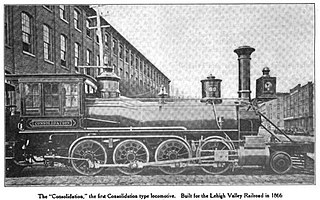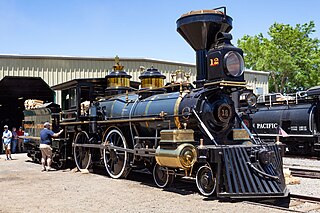
A Mallet locomotive is a type of compound articulated steam locomotive, invented by the Swiss engineer Anatole Mallet (1837–1919).

The Southern Pacific was an American Class I railroad network that existed from 1865 to 1996 and operated largely in the Western United States. The system was operated by various companies under the names Southern Pacific Railroad, Southern Pacific Company and Southern Pacific Transportation Company.

A 2-8-8-4 steam locomotive, under the Whyte notation, has two leading wheels, two sets of eight driving wheels, and a four-wheel trailing truck. The type was generally named the Yellowstone, a name given it by the first owner, the Northern Pacific Railway, whose lines ran near Yellowstone National Park. Seventy-two Yellowstone-type locomotives were built for four U.S. railroads.

Under the Whyte notation for the classification of steam locomotives, 4-8-4 represents the wheel arrangement of four leading wheels on two axles, eight powered and coupled driving wheels on four axles and four trailing wheels on two axles. The type was first used by the Northern Pacific Railway, and initially named the Northern Pacific, but railfans and railroad employees have shortened the name since its introduction. It is most-commonly known as a Northern.

The Atchison, Topeka and Santa Fe Railway, often referred to as the Santa Fe or AT&SF, was one of the largest Class 1 railroads in the United States.

The California State Railroad Museum is a museum in the California State Parks system that interprets the role of railroads in the West. It is located in Old Sacramento State Historic Park at 111 I Street, Sacramento, California.

Under the Whyte notation for the classification of steam locomotives, 2-8-0 represents the wheel arrangement of two leading wheels on one axle, usually in a leading truck, eight powered and coupled driving wheels on four axles, and no trailing wheels. In the United States and elsewhere, this wheel arrangement is commonly known as a Consolidation, after the Lehigh and Mahanoy Railroad’s Consolidation, the name of the first 2-8-0.

A rotary snowplow or rotary snowplough is a piece of railroad snow removal equipment with a large circular set of blades on its front end that rotate to cut through the snow on the track ahead of it. The precursor to the rotary snowplow was the wedge snowplow.
A 2-8-8-2, in the Whyte notation for describing steam locomotive wheel arrangements, is an articulated locomotive with a two-wheel leading truck, two sets of eight driving wheels, and a two-wheel trailing truck. The equivalent UIC classification is, refined to Mallet locomotives, (1'D)D1'. These locomotives usually employ the Mallet principles of articulation—with the rear engine rigidly attached to the boiler and the front engine free to rotate—and compounding. The 2-8-8-2 was a design largely limited to American locomotive builders. The last 2-8-8-2 was retired in 1962 from the N&W's roster, two years past the ending of steam though steam was still used on steel mill lines and other railroads until 1983.

The St. Louis–San Francisco Railway, commonly known as the "Frisco", was a railroad that operated in the Midwest and South Central United States from 1876 to November 21, 1980. At the end of 1970, it operated 4,547 miles (7,318 km) of road on 6,574 miles (10,580 km) of track, not including subsidiaries Quanah, Acme and Pacific Railway and the Alabama, Tennessee and Northern Railroad; that year, it reported 12,795 million ton-miles of revenue freight and no passengers. It was purchased and absorbed into the Burlington Northern Railroad in 1980. Despite its name, it never came close to San Francisco.
Under the Whyte notation for the classification of steam locomotives by wheel arrangement, a 2-6-6-2 is a locomotive with one pair of unpowered leading wheels, followed by two sets of three pairs of powered driving wheels and one pair of trailing wheels. The wheel arrangement was principally used on Mallet-type articulated locomotives, although some tank locomotive examples were also built. A Garratt locomotive or Golwé locomotive with the same wheel arrangement is designated 2-6-0+0-6-2 since both engine units are pivoting.

Under the Whyte notation for the classification of steam locomotives by wheel arrangement, 4-10-2 represents the arrangement of four leading wheels, ten powered and coupled driving wheels and two trailing wheels. In South Africa, where the wheel arrangement was first used, the type was known as a Reid Tenwheeler. In the United States of America it was known as a Southern Pacific on the Southern Pacific Railroad and as an Overland on the Union Pacific Railroad.

Atchison, Topeka and Santa Fe 3751 is a class "3751" 4-8-4 "Heavy Mountain" type steam locomotive built in May 1927 by the Baldwin Locomotive Works in Eddystone (Philadelphia), Pennsylvania for the Atchison, Topeka & Santa Fe Railway (ATSF). No. 3751 was the first 4-8-4 steam locomotive built for the Santa Fe and was referenced in documentation as type: "Heavy Mountain", "New Mountain", or "Mountain 4-wheel trailer". No. 3751 served in passenger duties until being retired in 1957.

The Western Pacific Railroad Museum (WPRM) in Portola, California, known as the Portola Railroad Museum until January 1, 2006, is a heritage railroad that preserves and operates historic American railroad equipment and preserves documents, photos and information. The museum's mission is to preserve the history of the Western Pacific Railroad and is operated by the Feather River Rail Society, founded in 1983. It is located at a former Western Pacific locomotive facility, adjacent to the Union Pacific's former Western Pacific mainline through the Feather River Canyon.

Southern Pacific 2472 is a P-8 Class 4-6-2 heavy "Pacific" type steam locomotive built by the Baldwin Locomotive Works for Southern Pacific Railroad (SP) in 1921. No. 2472 is one of three surviving Southern Pacific P-8 class 4-6-2 Pacific locomotives, the other two bring Nos. 2467 and 2479. The 4-6-2 designation means it has four leading wheels, six driving wheels, and two trailing wheels. The locomotive was used by the Southern Pacific Railroad to haul passenger trains until being retired in 1957. The locomotive was then donated to San Mateo County and placed on static display at the San Mateo County Fairgrounds. After being restored to operational condition in the early 1990s, the locomotive would pull excursion trains on the Niles Canyon Railway until being retired in 2015. The No. 2472 was then moved to the Northwest Pacific Railroad, where it is as of 2023, undergoing its Federal Railroad Administration (FRA) mandated 1,472 day inspection and overhaul.

Southern Pacific Railroad 2467 is a preserved 4-6-2 “Pacific” type steam locomotive. Built by Baldwin in 1921, it was used by the Southern Pacific Railroad to pull passenger trains until it was retired from service in 1956. On July 25, 1960, it was donated to the city of Oakland, California, who had it placed on display at the Harrison Railroad Park. In July 1990 a restoration began by the Friends of the 2467, which later merged into the Pacific Locomotive Association. In June 1999 it was returned to operation and made an appearance at Railfair 1999. Although serviceable, SP 2467 is currently on static display while on loan from its operator, Pacific Locomotive Association, Inc., to the California State Railroad Museum in Sacramento, California.

The history of the Union Pacific Railroad stretches from 1862 to the present. For operations of the current railroad, see Union Pacific Railroad; for the holding company that owns the current railroad, see Union Pacific Corporation.

The Southern California Railway Museum, formerly known as the Orange Empire Railway Museum, is a railroad museum in Perris, California, United States. It was founded in 1956 at Griffith Park in Los Angeles before moving to the former Pinacate Station as the "Orange Empire Trolley Museum" in 1958. It was renamed "Orange Empire Railway Museum" in 1975 after merging with a museum then known as the California Southern Railroad Museum, and adopted its current name in 2019. The museum also operates a heritage railroad on the museum grounds.

Southern Pacific No. 1744 is a preserved American class "M-6" 2-6-0 "Mogul" type steam locomotive built by the Baldwin Locomotive Works for the Southern Pacific Railroad in November 1901. Originally equipped with Vauclain compound cylinders, it was rebuilt with conventional cylinders in 1912. It operated for many years out of Oakland, California on the Southern Pacific's Western Division and in California's Central Valley where the locomotive and its classmates were fondly called “Valley Mallets” by their crews. The locomotive was made famous in later years by pulling some of the last steam excursions on the SP alongside other steam locomotives, including 4-8-4 4460. In 1959, No. 1744 was donated to the Sons of Utah Pioneers in Corinne, Utah where it remained on static display, until 1980. That year, it was restored by New London Railroad and Village Incorporated to operate on the Heber Valley Railroad in Heber City for the rest of the decade.

Virginia and Truckee Railroad No. 12, nicknamed Genoa, is a 4-4-0 American steam locomotive built by the Baldwin Locomotive Works in January 1873 for the Virginia and Truckee Railroad. She is one of three largely identical 4-4-0 locomotives built by Baldwin for the railroad, the others being the Reno and the Inyo, and one of four V&T 4-4-0's preserved.

















